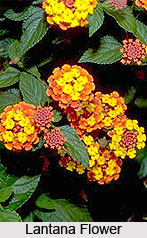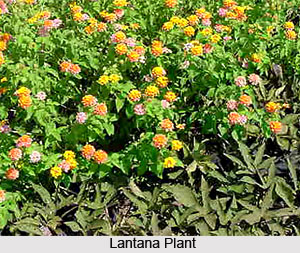 The `Lantana Shrub` is considered as one of the most common and most troublesome wild plants in India. It is known as `Lantana Aculeata` in science. It belongs to the family of `Verbenaceae`. The Shrub is well known as `Uni Cheddy` in Tamil language. In the Malayalam language, the name of the Shrub is `Arippu`. This Shrub is indeed a really charming garden plant if you cultivate it in a proper way.
The `Lantana Shrub` is considered as one of the most common and most troublesome wild plants in India. It is known as `Lantana Aculeata` in science. It belongs to the family of `Verbenaceae`. The Shrub is well known as `Uni Cheddy` in Tamil language. In the Malayalam language, the name of the Shrub is `Arippu`. This Shrub is indeed a really charming garden plant if you cultivate it in a proper way.
The Shrub has an amazing speed of spreading and it can also grow very rapidly. For this very reason, it has become a serious danger and it costs India many rupees in damage. The `Lantana Shrub` resembles a variety of `C. Camara`. It is occasionally considered that this variety can be very much useful in giving shelter to the young Sandalwood Shrubs. You can find this Shrub in all over the India abundantly, especially along the riverbanks of Bengal. It is a tedious and pointed shrub. The Shrub originated from the tropical America and it is said that, it has been brought to India from Australia by a planter.
The Shrub contains a strong smell of black currants. The smell is more evident when you touch the plant or trouble it. The branches are square in shape and pale green in colour. Sometimes they are hairy and sometimes they are armed with curvy spikes. The leaves of the `Lantana Shrub` are also hairy. However, in this case the hairs remain hidden. If anyone attempts to stroke one leave "against the pile", then it will immediately reveal the power and compactness of the little spikes. The leaves usually grow in pairs and their colour is bright clear green. Each of the pairs remains almost crosswise to the next. They are oval in shape and have the ability to reach about 7.5 cm. Length. They also have some pointed tips and a round-toothed edge. They are often wavy and underneath the countless veins, they are predominant. On the top, they give the Shrub a wrinkly effect.
 The Shrub bears flowers all through the year. The flowers of the `Lantana Shrub` normally grow on slender stalks from the axils of the leaves. For this reason, they also remain in pairs. A compact head of about 2.5 cm across is formed by twenty or thirty small flowers with long tubes. The flowers have some irregular petals and many of them have a charming presence, as they are multi-coloured. In the most common variety of this Shrub, the inner blooms are of deep cherry colour and the outer circles are bright orange. Both the inner and outer flowers have orange centres. In another common variety of the `Lantana Shrub`, there is an outer ring of orange centred and pink coloured flowers. Here, the flowers surround a group of pale yellow ones with dark yellow centres. There is a third variety where all the flowers are totally orange. They are usually cut short and grouped in a small trench vase. These flowers can easily make a gorgeous table decoration and people can obtain them when no other flowers are available.
The Shrub bears flowers all through the year. The flowers of the `Lantana Shrub` normally grow on slender stalks from the axils of the leaves. For this reason, they also remain in pairs. A compact head of about 2.5 cm across is formed by twenty or thirty small flowers with long tubes. The flowers have some irregular petals and many of them have a charming presence, as they are multi-coloured. In the most common variety of this Shrub, the inner blooms are of deep cherry colour and the outer circles are bright orange. Both the inner and outer flowers have orange centres. In another common variety of the `Lantana Shrub`, there is an outer ring of orange centred and pink coloured flowers. Here, the flowers surround a group of pale yellow ones with dark yellow centres. There is a third variety where all the flowers are totally orange. They are usually cut short and grouped in a small trench vase. These flowers can easily make a gorgeous table decoration and people can obtain them when no other flowers are available.
The fruit of the Shrub is a berry that is of green or blue-black in colour. The birds admire it very much and hence they spread the seeds widely and largely. They are very much responsible for the wild flower becoming such a menace. Nearly fifty varieties of the `Lantana Shrub` have been developed. All of the varieties contain the black currant smell as well as the hairy formation of the leaves. However, the flower heads differs in many lovely shades of violets, pinks, yellows and oranges. Amongst the varieties, the `L. Cloth` of Gold is all a brilliant yellow, the `L. Delicatissima` has a pale yellow coloured heart that is marked with deeper yellow and also surrounded by a circle of palest pink. Both the varieties of `L. Alba` and `L. Nivea` are white in colour and `L. Sanguinoa` is of deep red colour. Another variety, the `L. Selloviana` is an irregular dwarf that has pale purple coloured heads of flowers and this variety is more suitable to hang baskets and rockeries.



















